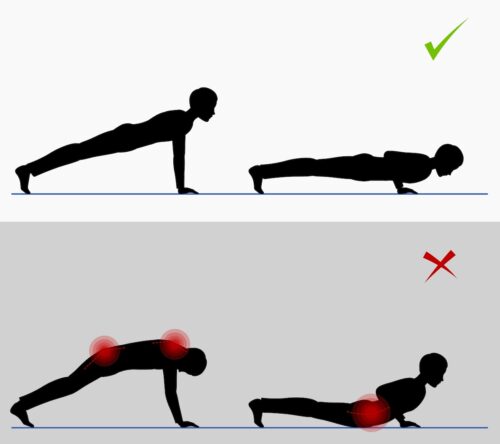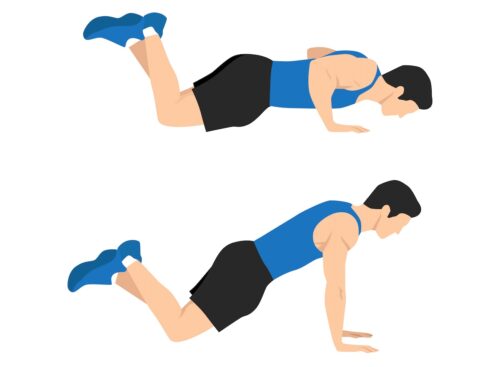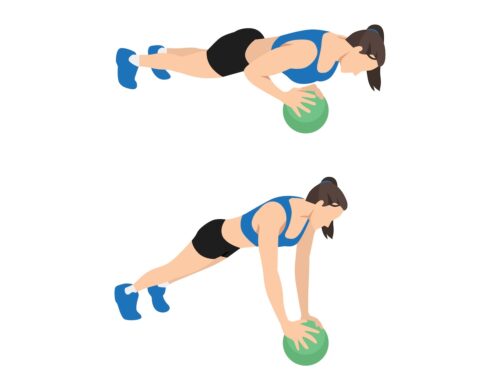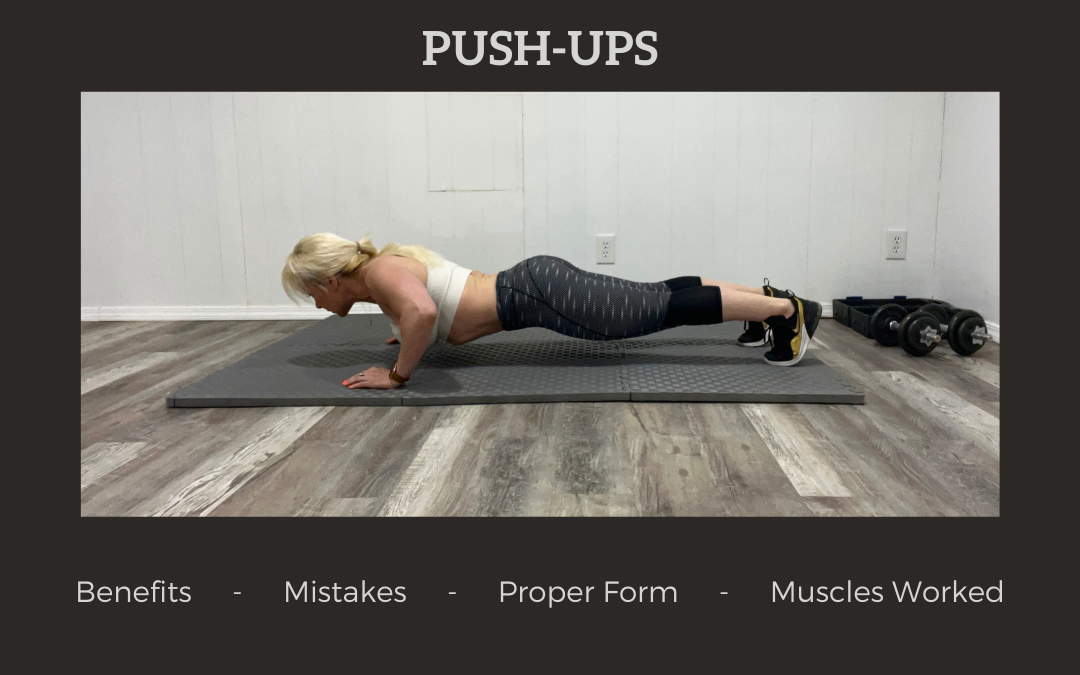One of the best bodyweight exercises is the push-up. It can have a positive impact on your whole body. Read on to learn what muscles push-ups work, the benefits and mistakes associated with the push-up, and the correct form to perform this exercise. Check out some ideas for your chest workout and watch the video to learn how to properly perform a push-up.
What Muscles Do Push-Ups Work?
- Chest Muscles: The pectorals are located on the chest area and are divided into the pectoralis major and pectoralis minor. The pectoralis major is the larger one, a fan-shaped muscle comprising most of the chest wall. It helps keep your arms attached to your body and is involved in adduction and internal rotation of the arm on the shoulder joint. It also allows for flapping, pressing, and lifting movements. The pectoralis minor is the smaller and flatter muscle. This one lies underneath the pectoralis major and is involved in shoulder functioning.
- Deltoids: These are the big muscles of the shoulder area. The anterior deltoid flexes and medially rotates the arm, the lateral deltoid abducts the arm, and the posterior deltoid extends and laterally rotates the arm. The anterior deltoids are targeted the most due to their location on the front of the shoulder joint.
- Triceps Brachii: The name triceps is due to the fact that these muscles are composed of three muscle strands (the long, medial, and lateral heads). The triceps are involved in forearm and elbow extension, helping extend or straighten the elbow. They are also involved in shoulder adduction and extension, helping pull the arms down. Additionally, the triceps help to stabilize the shoulder joint. During the part of the push-up when your chest is close to the floor, the triceps help stabilize your upper body. As you extend your arms and push your chest off the floor, the triceps are the primary movers.
- Rotator Cuff: This group of muscles and tendons surround the shoulder joint (supraspinatus, infraspinatus, teres minor, and subscapularis) and are responsible for stabilizing it.
- Trapezius: These diamond-shaped muscles extend from the top of the neck to the shoulder and down toward the mid-back. They attach to the skull, vertebral column, and shoulder girdle. They are involved in the movements of the shoulder girdle.
- Serratus Anterior: These muscles are located on the upper sides of the torso, wrapping the rib cage. The main part lies deep under the scapula and the pectoral muscles – in between the pectoralis major and latissimus dorsi muscles. They rotate and draw the scapula anterolaterally.
- Core Muscles: These include the abdominal muscles (rectus abdominis -referred to as the six-pack, transverse abdominal, the external and internal obliques, and pyramidalis), as well as the pelvic floor muscles, erector spinae, multifidus, and lumbar muscles. In conjunction, these core muscles keep your spine straight so you have proper form while performing push-ups.
?? You can increase the engagement of different muscles by changing the positioning of your hands:
- More Triceps: Placing your hands closer together – A narrow hand pushup increases activity in your triceps.
- More Chest and Shoulders: Placing your hands wider than a normal pushup increases chest and shoulder engagement.
- More Upper Chest: Placing your feet on an elevated surface so your body is angled down targets the upper chest.
- More Biceps: Rotating your wrists and forearms to point your fingers back, engages the biceps.
Benefits of Push-Ups
After learning the muscles involved in the push-up, let’s look at the vast benefits associated with this exercise:
- Aesthetics: Push-ups sculpt your upper body beautifully. Your chest gets higher and your shoulders and arms develop great curves.
- Calorie Burner: The bench press is a compound exercise that engages numerous muscle groups. Due to greater muscle involvement, caloric expenditure is higher helping you to burn more fat.
- Strength: The pushup increases functional strength since it involves several muscles and joints in the movement. It not only makes your chest muscles stronger but your whole upper body and core. This helps facilitate the proper performance of other movements, such as chest and shoulder presses as well as tricep exercises.
- Time Efficiency: Being a multi-joint movement, the push-up works several muscles at the same time, making you highly efficient during your workouts. At the same time, it forces the cardiovascular system to work harder.
- Increased HGH (Human Growth Hormone) and Testosterone production: Push-ups help produce these important hormones, which translates into a higher ability to burn fat, maintain lean muscle, and increase energy levels.
- Bone Health: Greater muscle recruitment converts into increased bone health and lower incidences of osteoporosis.
- Better Posture & Less Back Pain: Strengthening the upper body and core muscles helps improve posture and prevent back pain and injuries.
- Simple: There is no need for equipment. You only need your body and motivation. Anyone can perform push-ups – If you are a beginner, you can start on your knees.
How to Do Push-Ups
- Go on a plank position – your hands at chest level and positioned slightly wider than shoulder-width apart. Your feet should be hip-width apart and parallel to each other—not turning inward or outwardly. Your hips, shoulders, and head should be in line. The hips shouldn’t drop down toward the floor or be elevated.
- Before getting started, squeeze your glutes and engage your core – bring your belly button toward your spine and keep your abdominals tight.
- Inhale as you slowly bend your elbows and lower yourself to the floor, until your elbows are at a 90-degree angle.
- Exhale as you contract your chest muscles and push your body up through your hands to the starting position without locking your elbows.
- Keep your core tight throughout the entire movement and your body in a straight line from head to toe.
- Perform the desired number of repetitions based on your goals and ability.
? Avoid push-ups if you have shoulder, wrist, or elbow injuries. Get clearance before performing this exercise.
? If you feel sharp pain or hear clicking in your shoulder, wrists, or elbows during the push-up, stop.

Push-Up Variations
The push-up is a great exercise because it can be adjusted according to your level of athleticism:
Easier Push-Ups:
If you are a beginner, you can start by doing them on your knees, or by placing your arms on an elevated surface, or on a wall. If you are pretty fit and want to challenge yourself, you can try different variations according to your goals and physical state.
- Wall Push-Ups: This is the easiest version. Instead of doing the push-up on the floor, you perform the same motion standing up against the wall.
- Incline Push-Up: This variation is a little bit easier than the standard push-up. It involves the same technique but your hands are not at floor level but on a raised surface, such as a bench or table.
- Knee Push-Up: This is the basic modified version of the standard push-up. Instead of doing it on your toes, you can perform it on your knees. Just make sure to keep the knees, hips, and shoulders all in a straight line. Watch the video Modified Knee Push-Ups.

Harder Push-Ups:
- Weighted Push-Up: Wear a weighted vest or belt/chain around you to make you heavier. This increases the resistance – the amount of weight you have to lift.
- One-leg pushups: Instead of keeping both feet on the floor, you keep one leg in the air while doing the pushups. Be mindful to switch legs so you don’t create imbalances.
- One-arm pushups: Instead of having both hands on the floor, you place one arm behind your back.
- Decline Push-Up: This variation of the standard pushup is for people who are more advanced since it’s a little bit more difficult. It aims to target the upper chest more. It is performed in the same manner as the standard push-up. However, the feet are elevated above your hands, angling down the body. You can place your feet raised up on a box, chair, or bench. Watch the video Decline Push-Ups.
- Stability-Ball Push-Up: This variation is more difficult than the standard pushup. It challenges further core stability. You just do the push-up on a stability ball or BOSU.
- Medicine Ball Push-Up: Here you perform a standard push-up with one hand on top of a medicine ball and the other hand on the floor. You alternate your hand on the ball by rolling it between each hand after each rep. This engages the muscles in a slightly different angle and range of motion, increasing shoulder stability.

- Spiderman Pushups: This variation adds more intensity to the core muscles and the obliques. You also engage your hips and legs, particularly your quadriceps. The difference during this push-up is that after you lower your chest toward the floor, you pick up your right foot and draw your right knee up and out, so your right knee reaches toward your elbow. Then, you do another push-up and do the same thing with the opposite leg. Watch the video Spiderman Pushups
- Diamond Push-Up: This push-up variation targets the triceps more. In the diamond push-up, you position your hands close together – not shoulder-width apart. The index fingers and thumbs of one hand touch the other hand, making a diamond shape on the floor. When you come down, your hands touch the center of your chest and elbows close to your sides during each rep.
- Push-Up With Renegade Rows: This variation adds alternating renegade rows to the top of each rep. This push-up introduces weights and adds great intensity to the exercise. Besides working on all the muscles involved during the pushup, this one activates further your core stabilizers and targets your back muscles. Watch the video Renegade Rows with Push-Ups.
- Plyo Push-Up or Clapping Push-Up: This variation is very challenging and not recommended for beginners. It involves plyometrics, an all-out effort in an exercise. In the plyo push-up, you lower your body down but on the way up, you push yourself up with enough power so that your hands come off the floor and you clap while you are in midair. Watch the video Plyo Push-Ups.
If you want to add more variety to your routine, you can also try side-to-side push-ups, staggered push-ups, push-up jacks, pike push-ups, or inverted wall push-ups. As you can see, you can perform push-ups in many different ways.
Push-Up Mistakes
Now you know how to perform push-ups with the correct form. Next, let’s look into the most common mistakes associated with the exercise:
- Doing Half-Reps: If you are not going all the way down on your push-up, you are doing half-reps. This limited range of motion doesn’t allow you to reap all the benefits from the exercise from performing the exercise.
- Dropping Your Hips/Belly: Sagging in the middle happens when you are not properly engaging your core throughout the movement and your lower back is not aligned. Your abs should be tight and your lower back should have a neutral curve – not completely flat or overly curved either.
- Locking Your Elbows: When you lock your elbows at the top of the movement, you place too much stress on the joints. This can cause strains or an injury. Always keep a slight bend in the elbows.
- Lifting or Dropping Your Head: Your neck should be in neutral alignment. Your hips, shoulders, and head should be in line. Lifting your head so your chin is pointing up or dropping it so you are facing your toes instead of the floor takes you out of alignment.
- Placing Your Hands Too Far Forward: Your hands should still be positioned under your shoulders. When they are farther out than shoulder level, you overstress your shoulder joints, which can lead to injury.
Push-Ups Video Tutorial
Chest Workout
You can complete your chest workout by performing a couple of different types of push-ups, plus the following exercises:
As you can see the push-up is an exceptional exercise. It offers tremendous benefits associated with hypertrophy, strength, endurance, and aesthetics. Now that you know how to properly perform push-ups, you can avoid the most common mistakes and enjoy their benefits.
Whether you want to lose weight, tone your body, gain muscle, or get stronger, all muscles must be trained.
Lift, Burn more Fat, Get Stronger, and Live Healthier!
To a Fitter Healthier You,
The Fitness Wellness Mentor



